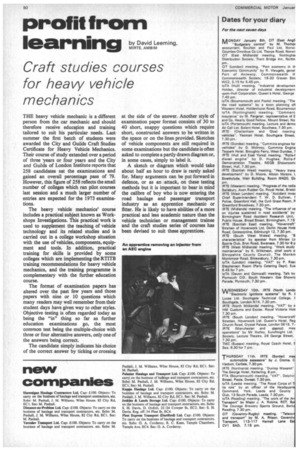profit from learning
Page 52

If you've noticed an error in this article please click here to report it so we can fix it.
by David Leeming,
MIRTE, AMBIM
Craft studies courses for heavy vehicle mechanics
THE heavy vehicle mechanic is a different person from the car mechanic and should therefore receive educalion and training tailored to suit his particular needs. Last summer the first batch of students were awarded the City and Guilds Craft Studies Certificate for Heavy Vehicle Mechanics. Their course of study extended over a period of three 'years or four years and the City and Guilds of London Institute reports that 258 candidates sat the examinations and gained an overall percentage pass of 79. However, this figure of 258 reflects the small number of colleges which ran pilot courses last session and a much larger number of entries are expected for the 1973 examinations.
The heavy vehicle mechanics' course includes a practical subject known as Workshops Investigations. This practical work is used to supplement the teaching of vehicle technology and its related studies and is carried out in a college workshop situation with the use of vehicles, components, equipment and tools. In addition, practical training for skills is provided by some colleges which are implementing the RTITB training recommendations for heavy vehicle mechanics, and the training programme is complementary with the further education course.
The format of examination papers has altered over the past few years and those papers with nine or 10 questions which many readers may well remember from their student days have given way to other styles. Objective testing is often regarded today as being the "in" thing so far as further education examinations go, the most common test being the multiple-choice with three or four alternative answers, only one of the answers being correct.
The candidate simply indicates his choice of the correct answer by ticking or crossing at the side of the answer. Another style of examination paper format consists of 30 to 40 short, snappy questions which require short, constructed answers to be written in the space or on the lines provided. Sketches of vehicle components are still required in some examinations but the candidate is often asked to complete a partly drawn diagram or, in some cases, simply to label iL A sketch or diagram which would take about half an hour to draw is rarely asked for. Many arguments can be put forward in defence, or as an attack, on these testing methods but it is important to bear in mind the calibre of boy who is now entering the road haulage and passenger transport industry as an apprentice mechanic or fitter. He is likely to have abilities of a more practical and less academic nature than the vehicle technician or management trainee and the craft studies series of courses has been devised to suit these apprentices.




























































































